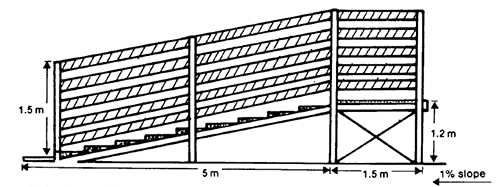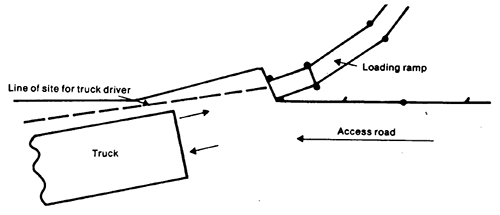Cattle loading ramps
This design is based on the loading ramp built at Rutherglen Research Station.
Building your own ramp
Studies of the length and movement of an animal's stride have shown that steps at least 450mm long, and with no more than 100mm rise, promote the easiest loading. This means a slope of about 20°.
The traditional cleated ramp will baulk cattle because often it is too steep, and the cattle are not able to support all the hoof because of the slope and the size of the cleats.


Cleated ramps
If a cleated ramp is to be used, the cleats should be 200mm apart and they should rise at least 40mm above the ramp for a slope of 1 in 5. Cleats need to protrude higher for steeper slopes.
Preparing the ramp for cattle getting on and off the truck
A slight curve or deviation in ramp direction will improve the animals' willingness to move up the ramp.
A level section at the top of the ramp about 1.5 metres long will give cattle more confidence to move onto the different flooring material in the truck.
This is also very important when unloading cattle from the top deck of a double deck transport. The internal ramps on these vehicles are often very steep, and a level section to slow the cattle down is worthwhile.
Key points:
- A spring-loaded buffer on the front of the ramp will protect both the ramp and the vehicle from damage. The buffer will also adjust to the angle of the truck to ensure that there are no spaces for the cattle to fall and break legs in.
- The ramp should be situated so that the truck driver may back in with a good view from the driver's side. It is almost impossible for a semi-trailer to be backed accurately to a ramp on left-hand lock.
- If a sloping site is available, it may be possible to site the ramp above a roadway cutting. The 'ramp' can then be built level.
- A raised walk-way makes loading easier for the operator.
- The vehicle approach should have a slight fall back to the ramp to enable the truck to be gently rolled into position.
- Loading height will vary slightly with the type of truck to be used. An average height is 1.2 metres.
- Side panels should be at least 1.5 metres high. The best internal width between rails for loading is 750mm.
For unloading only, a truck-width ramp as used for unloading machinery can be used.
